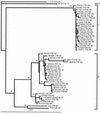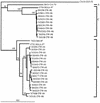Change of major genotype of enterovirus 71 in outbreaks of hand-foot-and-mouth disease in Taiwan between 1998 and 2000
- PMID: 11773085
- PMCID: PMC120096
- DOI: 10.1128/JCM.40.1.10-15.2002
Change of major genotype of enterovirus 71 in outbreaks of hand-foot-and-mouth disease in Taiwan between 1998 and 2000
Abstract
Two outbreaks of hand-foot-and-mouth disease (HFMD) occurred in Taiwan between 1998 and 2000. Enteroviruses were isolated from a total of 1,892 patients in this laboratory during this period. Of the virus isolates, enterovirus 71 (EV71) was diagnosed in 44.4% of the patients (132 of 297) in 1998, 2% (13 of 646) in 1999, and 20.5% (195 of 949) in 2000. Genetic analyses of the 5'-untranslated and VP1 regions of EV71 isolates by reverse transcription-PCR and sequencing were performed to understand the diversity of EV71 in these outbreaks of HFMD. Most EV71 isolates from the 1998 epidemic belonged to genotype C, while only one-tenth of the isolates were genotype B. Interestingly, all EV71 isolates tested from 1999 to 2000 belonged to genotype B. This study indicated that two genogroups of EV71 capable of inducing severe clinical illness have been circulating in Taiwan. Furthermore, the predominant EV71 genotypes responsible for each of the two major HFMD outbreaks within the 3-year period in Taiwan were different.
Figures


Similar articles
-
Genetic analysis of enterovirus 71 isolated from fatal and non-fatal cases of hand, foot and mouth disease during an epidemic in Taiwan, 1998.Virus Res. 2000 Jul;68(2):127-36. doi: 10.1016/s0168-1702(00)00162-3. Virus Res. 2000. PMID: 10958984
-
Enterovirus 71 from fatal and nonfatal cases of hand, foot and mouth disease epidemics in Malaysia, Japan and Taiwan in 1997-1998.Jpn J Infect Dis. 1999 Feb;52(1):12-5. Jpn J Infect Dis. 1999. PMID: 10808253
-
Etiology of Multiple Non-EV71 and Non-CVA16 Enteroviruses Associated with Hand, Foot and Mouth Disease in Jinan, China, 2009-June 2013.PLoS One. 2015 Nov 12;10(11):e0142733. doi: 10.1371/journal.pone.0142733. eCollection 2015. PLoS One. 2015. PMID: 26562154 Free PMC article.
-
Molecular epidemiology and evolution of human enterovirus 71 and hand, foot and mouth disease.Yi Chuan. 2015 May;37(5):426-35. doi: 10.16288/j.yczz.14-255. Yi Chuan. 2015. PMID: 25998430 Review.
-
Human enterovirus 71 epidemics: what's next?Emerg Health Threats J. 2013 Sep 10;6:19780. doi: 10.3402/ehtj.v6i0.19780. Emerg Health Threats J. 2013. PMID: 24119538 Free PMC article. Review.
Cited by
-
Cell surface nucleolin facilitates enterovirus 71 binding and infection.J Virol. 2015 Apr;89(8):4527-38. doi: 10.1128/JVI.03498-14. Epub 2015 Feb 11. J Virol. 2015. PMID: 25673703 Free PMC article.
-
Sensitive and specific detection of strains of Japanese encephalitis virus using a one-step TaqMan RT-PCR technique.J Med Virol. 2004 Dec;74(4):589-96. doi: 10.1002/jmv.20218. J Med Virol. 2004. PMID: 15484282 Free PMC article.
-
Vascular endothelial growth factor receptor 2 as a potential host target for the inhibition of enterovirus replication.J Virol. 2024 Oct 22;98(10):e0112924. doi: 10.1128/jvi.01129-24. Epub 2024 Sep 17. J Virol. 2024. PMID: 39287389 Free PMC article.
-
Modeling the Dynamic of Multiwave Diseases: The Model of Hand, Foot and Mouth Disease.Viruses. 2024 Jul 29;16(8):1217. doi: 10.3390/v16081217. Viruses. 2024. PMID: 39205191 Free PMC article.
-
Molecular evidence of persistent epidemic and evolution of subgenotype B1 coxsackievirus A16-associated hand, foot, and mouth disease in China.J Clin Microbiol. 2010 Feb;48(2):619-22. doi: 10.1128/JCM.02338-09. Epub 2009 Dec 16. J Clin Microbiol. 2010. PMID: 20018819 Free PMC article.
References
-
- Anonymous. 2000. Enterovirus surveillance—United States, 1997–1999. Morb. Mortal. Wkly. Rep. 49:913–916. - PubMed
-
- Brown, B. A., and M. A. Pallansch. 1995. Complete nucleotide sequence of enterovirus 71 is distinct from poliovirus. Virus Res. 39:195–205. - PubMed
-
- Ho, M., E. R. Chen, K. H. Hsu, S. J. Twu, K. T. Chen, S. F. Tsai, J. R. Wang, and S. R. Shih. 1999. An epidemic of enterovirus 71 infection in Taiwan. N. Engl. J. Med. 341:929–935. - PubMed
-
- Ho, M. 2000. Enterovirus 71: the virus, its infections and outbreaks. J. Microbiol. Immunol. Infect. 33:205–216. - PubMed
Publication types
MeSH terms
Substances
Associated data
- Actions
- Actions
- Actions
- Actions
- Actions
- Actions
- Actions
- Actions
- Actions
- Actions
- Actions
- Actions
- Actions
- Actions
- Actions
- Actions
- Actions
- Actions
- Actions
- Actions
- Actions
- Actions
- Actions
- Actions
- Actions
- Actions
- Actions
- Actions
- Actions
- Actions
- Actions
- Actions
- Actions
- Actions
- Actions
- Actions
- Actions
- Actions
- Actions
- Actions
- Actions
- Actions
- Actions
- Actions
- Actions
- Actions
- Actions
- Actions
- Actions
- Actions
- Actions
- Actions
- Actions
- Actions
- Actions
- Actions
- Actions
- Actions
- Actions
- Actions
- Actions
- Actions
- Actions
- Actions
- Actions
- Actions
- Actions
- Actions
- Actions
- Actions
- Actions
- Actions
- Actions
- Actions
- Actions
- Actions
- Actions
LinkOut - more resources
Full Text Sources
Other Literature Sources

